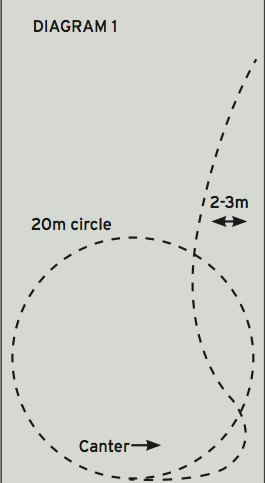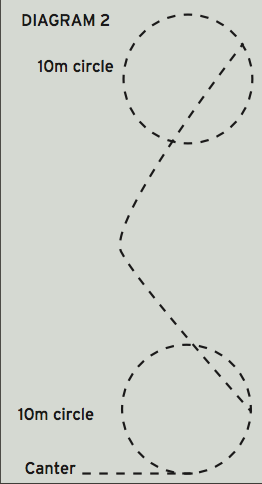The dressage trainer shares her exercise using loops to improve the canter
Aim
As a dressage judge, I often see horses and riders at the lower levels that simply can’t canter properly. The horses aren’t straight and are unbalanced. Using loops, especially if combined with circles, the horse can be taught to find its balance and sit more on its hindlegs. The result is a much better canter. It is a useful suppling exercise at every stage of the horse’s training.
The exercise also makes the rider think about their own position, how they are positioning their horse and they learn to ride more correctly to the outside rein through changes of direction.
The exercise
1. Put your horse into a working canter. On the short side of the arena, canter a 20-metre circle. Go large and at the first marker, ask the horse to come in off the track for two to three metres before going straight and then changing the direction in a shallow counter-canter back to the track. Ride a neat corner and then repeat. Do the exercise on both reins. (See diagram 1).

2. As the horse gains its confidence and balance, increase the depth of the loop and decrease the size of the circle beforehand. If the horse starts to fall onto its shoulder or the quarters swing, go back to a shallow loop until the balance is established.
3. Ride a 10-metre canter circle at M or H, then ride straight towards the centre line. Straighten for a few steps on the centre line over X and then turn back towards the track. Ride another 10m circle at the corner marker. Repeat on both reins. (See diagram 2).

Article continues below…
You might also be interested in:

8 things you may not know about Jennie Loriston-Clarke
We take a look at some of the many highlights of Jennie’s career, and some things you may not have

Subscribe to Horse & Hound this spring for great savings
Tips and pitfalls
● The rider must keep their weight evenly distributed in the centre of the saddle, particularly in the counter-canter section. Keep the legs in the correct position: outside leg back and inside leg on the girth creating the impulsion.
● In both exercises, ask for very little bend over the leading leg — eventually you should be able to do it with the horse’s neck completely straight.
● Adjust where you start the relevant loops depending on the size of your arena — in a 20x60m arena, make the loop deeper.
● Note in point three, make sure you ride straight towards the centre line and straight back to the track as this way the horse learns to stay into the outside rein.
● These exercises are the first steps of teaching a horse the three-loop canter serpentine. Eventually you can miss out the circles and ride three loops to each side of the arena.
For more extensive dressage features, don’t miss this week’s issue of Horse & Hound, out on Thursday 7 February 2019, where you will find our dressage special

